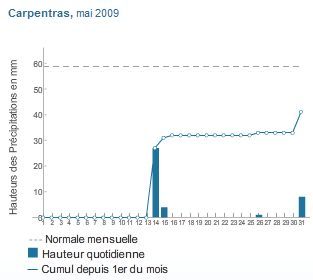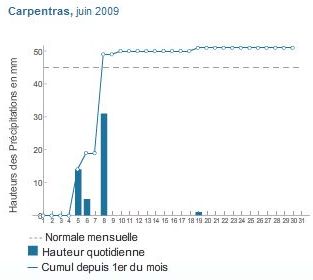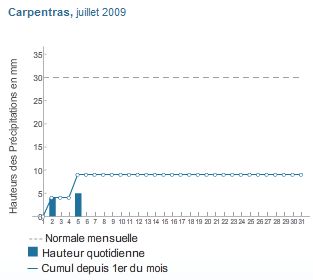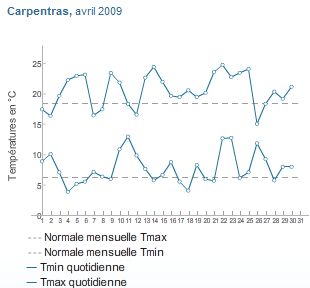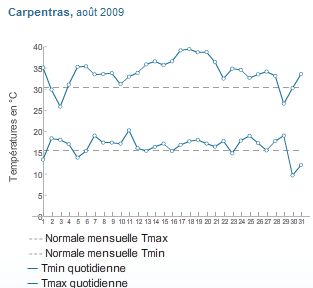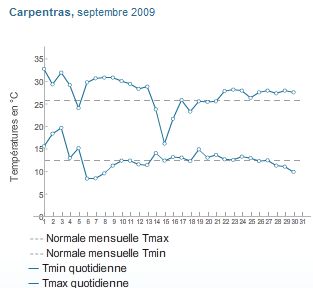Årgang 2009
Vækstperioden i 2009 var præget af ikke helt optimale betingelser i blomstring- og frugtsætningsperioden i april.
Dette betingede et lavere udbytte, som har kunnet forudsiges i hele
vækstperioden. Måske vil udbyttet blive 15-20% mindre end normalt.
Tidsrummet fra frugtsætning til høst har haft få, men meget vigtige,
kortvarige nedbørsperioder
(diagrammer herunder). I slutningen af juli berettede producenterne, at
der var tilstrækkelige vandresoursser i jorden til, at en tør periode
indtil høsten ikke ville kunne få betydende negativ indflydelse på kvaliteten. Der
fulgte en temmelig tør periode fra 2. august til 14. september, oven i
købet med relativt høje temperaturer. Det var lige før, at druerne
blev stressede af mangel på fugtighed.
Høsten startede, usædvanligt tidligt, i de sidste dage i august og
blev afsluttet på én måned. 16.- 18. september faldt en del nedbør i
området. En mindre del af producenterne havde allerede da afsluttet
høsten, og de, der ikke havde, beretter, at regnen var velgørende og
bibragte druerne/mosten vitalitet. Den resterende del af høstperioden bragte igen meget flot - tørt og varmt - høstvejr.
Med de kortvarige nedbørsperioder må vækstsæsonen have været ideel
for biologiske og biodynamiske producenter uden stor og gentagen risiko
for angreb af skimmel og meldug - som det var tilfældet i 2008.
Det bemærkes, at de anførte nedbørs- og
temperaturoplysninger gælder for Carpentras-området.(20 km fra
Chateauneuf du Pape og 16 km fra Gigondas)
Kilde: Meteo France.
.
|
Nalys
i nyhedsbrev 8.10.:
At the moment, although we’ve noticed that yields will be low (less
than 30 HL/ha),
quality will be up to expectations.
We’ve already seen very nice colour intensity and good pH levels.
Julien Barrot på blog 28.9.:
"Tomorrow we finish the grape harvest. We are very happy,
harvest is superb!" |
|
Jean-Marc Espinasse
i mail 30.9.:
"Outstanding
vintage is in process" (dvs. i gang med gæringen)
Beaucastel
23.9.:
"At this stage we are very happy of the quality of
the vintage"
Clos de Caveau i
mail 17.9.:
"...it is exceptionally good… not too high in
alcohol, around 13.5 to 14 degrees, but also very
balanced, with generous acidities (acidité total) which
will give a nice roundness… Probably the best of the
decade! |
|
| . |
|
Foreløbig
vurdering af Robert Parker (13.10)
2009
in France
Having been in France in late August and early September, this is
going to be a potentially great vintage in virtually every wine
region. In thirty years of visiting France in the fall, and seeing
how vintages unfold, I don't remember a better set of climatic
conditions than those that occurred in the critical months of
August and September as well as the early part of October, 2009.
Burgundy, Loire, Alsace, Bordeaux, the northern Rhône and
probably the southern Rhône as well appear to have had phenomenal
vintages, which is certainly good news. If there is going to be
any weaknesses, it may be because of the severe drought France
suffered, which was abated somewhat in certain areas by some late
rain in September. That may have caused some hydric stress and
tannin issues with some wines, but we won't know for sure until
the wines are tasted in the spring of 2010.
|
| . |
Blog
Beaucastel 5.11.:
"We are very happy with the 2009 harvest. The grapes were
healthy with great fruit and good extraction and the first
tastings show that we shall be making some great wine with soft
tannins and great structure. Despite the hot temperatures we
managed to maintain a good acidity thanks to the cooler
temperatures at night. You could compare this vintage
to 2005 and 2007." |
| . |
| Beaucastel
27.9. 2010 på blog.
Despite
a cold and snowy winter, spring in 2009 was mild and humid with no
frost after February. It was an extremely hot and dry summer
with less than 30mm rain between June 9th and September
14th, even drier than 2007 and very few days of
Mistral. The temperatures throughout the summer went up
progressively in June and July and ended up with a peak the last 2
weeks of August with temperatures as high as 40°C. This made it
the second hottest August in 47 years after 2003 but the nights
were cool.
Due
to the high temperatures in August, the ripening of the grapes was
accelerated, not because of the phenolic maturity but because of
dehydration. Therefore we decided to wait and not harvest the reds
too early and hope for further maturity.
The
quality of this vintage reflects the climatic conditions during
the vegetative stage. The rain in the spring and the hot summer
gave very healthy colourful grapes with great tannin structure.
The sorting was minimal.
We
started harvesting the whites on the 24th of August.
The whites have great fruit and good acidity level and are well
balanced. We had perfect weather conditions throughout harvest
with maximum temperatures running between 20°C and 30°C during
the whole month of September.
We
started the red harvest with Syrah on 31st August and
followed with the Grenache on 18th September. The phenolic
maturity had just turned by then and the Grenache had a nice
colour, good maturity and great fruit. 2009 was a very good
vintage for Grenache.
September
16th we had just over 60mm of rain followed by Mistral
which we were all waiting for. The vines were suffering from
hydrous stress and after that date the ripeness started moving
fast. We waited till the beginning of the following week to resume
harvest after a couple of days of Mistral. The end of the harvest
went very fast. We finished the Grenache and started the Mourvèdre
on 24 September. The rain helped the Mourvèdre a lot and we
are very happy with the results.
Yields
in 2009 were average with 25 hl/hec. Fermentations went off well
and the last devattings took place beginning of November. We
blended the 2009 reds in June and July this year and we will be
bottling the whites after harvest.
We
are very happy with the 2009 harvest. The grapes were healthy with
great fruit and good extraction and the tastings confirm that we
produced great wines in 2009 with soft tannins and great
structure. Despite the hot temperatures we managed to maintain a
good acidity thanks to the cooler temperatures at night. You
could compare this vintage to 2005 and 2007 and like them you
should cellar this vintage.
Robert
Parker 30. oktober 2010 Issue #191
2009: When
I was in the southern Rhône during the last two weeks of August,
2009, everyone agreed that the only thing needed for a great
vintage was rain. Not a deluge, but a good 25-35 mm (an inch to an
inch and a quarter) to relieve the stress that many vineyards were
beginning to experience because of the excessive drought. Some
rain did arrive, but not nearly enough. Because of that, 2009 has
turned out to be an excellent vintage with a number of top wines,
but it is not a great year in the south. Fermentations were tricky
because of very high sugars, pHs and alcohols. There were volatile
acidity issues as well as stuck fermentations. Consequently,
patience was needed until the fermentations were finished and the
wines were dry. Because of that, there was also a potential for
bacterial spoilage, but all the conscientious producers appear to
have fared well. In the south, tannins could have been a major
issue because of the drought, but that is largely not the case
where producers were careful to not prolong extractions and
macerations.
This vintage is reminiscent of a hypothetical blend of 2003 and
2000. In 2003, a drought also caused major issues and in 2000,
producers made wines with relatively high alcohols (although not
as high as in 2007, 2006 or 2005) that have turned out to be
well-balanced. Interestingly, Châteauneuf du Pape, which is
clearly the finest as well as most prestigious appellation in the
south, had more variation in quality than the outlying areas. In
fact, in Gigondas and Vacqueyras one could argue that 2009 may end
up to be nearly as profound as 2007. In addition, some of the less
well-drained terroirs that encompass the Côtes du Rhône
appellations also fared well in this drought year.
At the minimum, 2009 is an excellent vintage in the south, but the
overall quality is behind what was achieved in 2007, and probably
not superior to 2005, 2001 and 1998. The good news is that prices
are stable, and there is no justification for the majority of the
southern Rhône producers to raise prices. Of course, much depends
on the fluctuating American dollar which strengthened considerably
in late spring and early summer, only to weaken considerably in
the last month.
|
|

